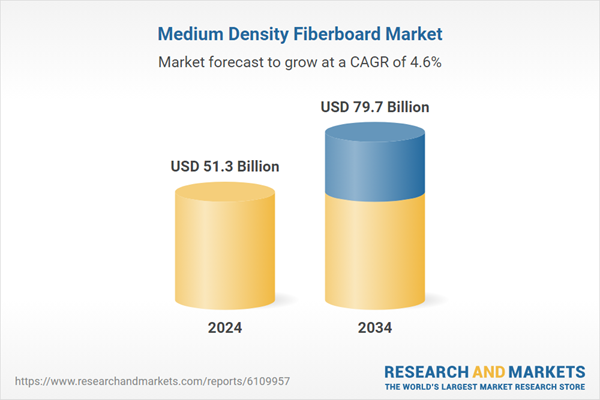Growth in the residential sector, driven by rapid urbanization and a surge in population, continues to elevate demand for modern, wooden furniture built with MDF panels. As more individuals migrate to cities and housing development accelerates, there’s a rising preference for space-efficient, affordable, and aesthetically pleasing furniture solutions. MDF panels meet these needs due to their adaptability, smooth surface, and compatibility with a wide range of finishes and designs. Consumers are increasingly favoring ready-to-assemble and modular furniture styles, which are often manufactured using MDF for its ease of machining and durability. Moreover, sustainability trends are pushing buyers toward engineered wood alternatives, further reinforcing MDF as a go-to material for cost-effective, durable, and eco-friendly home furnishing solutions in new and remodeled urban dwellings.
In 2024, standard MDF generated USD 16.5 billion and is forecasted to grow at a CAGR of 4.6% through 2034. This segment continues to gain popularity in the furniture and construction markets due to its flexibility and competitive pricing. Its ability to serve as an affordable substitute for traditional wood has increased its presence in flooring, cabinetry, and other structural components. Expansion in commercial and residential construction projects, particularly in European regions, will likely create further momentum for standard MDF panels over the forecast period. The ease of customization and high-quality finish it offers plays a crucial role in its rising demand.
The furniture sector accounted for USD 18 billion in market value in 2024 and is projected to grow at a 4.7% CAGR between 2025 and 2034. This segment is expected to maintain a dominant share in MDF usage, as manufacturers lean toward eco-friendly and economical raw materials such as reforested wood derivatives. The demand for pre-assembled and low-maintenance furniture has surged, with consumers seeking aesthetic, durable, and compact solutions suited for modern living spaces. MDF allows detailed machining and precision cutting, ideal for intricate furniture designs. Additionally, with remote work becoming a long-term trend, there's a noticeable shift toward ergonomic and space-saving MDF-based furniture for home offices, which further drives segment expansion.
U.S. Medium Density Fiberboard Market generated USD 7.7 billion in 2024 and is expected to grow at a CAGR of 5.6% from 2025 to 2034. Growth in this region stems from robust use of MDF in both residential and commercial construction projects. Rising interest in sustainable and budget-conscious alternatives to solid wood has fueled the adoption of MDF across cabinetry, paneling, and interior decor. Home renovations surged during the pandemic, which directly increased demand for MDF-based furnishings. Additionally, increasing focus on eco-friendly materials, especially those with low emissions and made from recycled content, continues to strengthen market expansion in the U.S. market, where environmental regulations are shaping buying behavior.
Key companies working to gain a competitive edge in the Medium Density Fiberboard Market include West Fraser Timber, Kastamonu Entegre, Dare Panel Group, ARAUCO, Egger Group, Unilin, Greenply Industries, Georgia-Pacific, Evergreen Fiberboard, TRENOX Laminates, Kronospan, Century Plyboards, Dongwha Malaysia Holdings, Norbord, and Nag Hamady Fiber Board. To strengthen their market position, MDF manufacturers are focusing on capacity expansions, product diversification, and technological advancements in production. Several companies are investing in eco-friendly alternatives and formaldehyde-free resins to meet rising environmental standards. Innovation in lightweight yet durable MDF boards tailored for modular furniture and prefabricated housing is a key growth strategy. Partnerships with furniture producers, home improvement retailers, and construction firms enable better distribution and access to high-demand regions. Additionally, firms are leveraging digital platforms and B2B networks to expand market reach.
Comprehensive Market Analysis and Forecast
- Industry trends, key growth drivers, challenges, future opportunities, and regulatory landscape
- Competitive landscape with Porter’s Five Forces and PESTEL analysis
- Market size, segmentation, and regional forecasts
- In-depth company profiles, business strategies, financial insights, and SWOT analysis
This product will be delivered within 2-4 business days.
Table of Contents
Companies Mentioned
- ARAUCO
- Century Plyboards
- Dare Panel Group
- Dongwha Malaysia Holdings
- Egger Group
- Evergreen Fiberboard
- Georgia-Pacific
- Greenply Industries
- Kastamonu Entegre
- Kronospan
- Nag Hamady Fiber Board
- Norbord
- TRENOX Laminates
- Unilin
- West Fraser Timber
Table Information
| Report Attribute | Details |
|---|---|
| No. of Pages | 225 |
| Published | June 2025 |
| Forecast Period | 2024 - 2034 |
| Estimated Market Value ( USD | $ 51.3 Billion |
| Forecasted Market Value ( USD | $ 79.7 Billion |
| Compound Annual Growth Rate | 4.6% |
| Regions Covered | Global |
| No. of Companies Mentioned | 15 |









